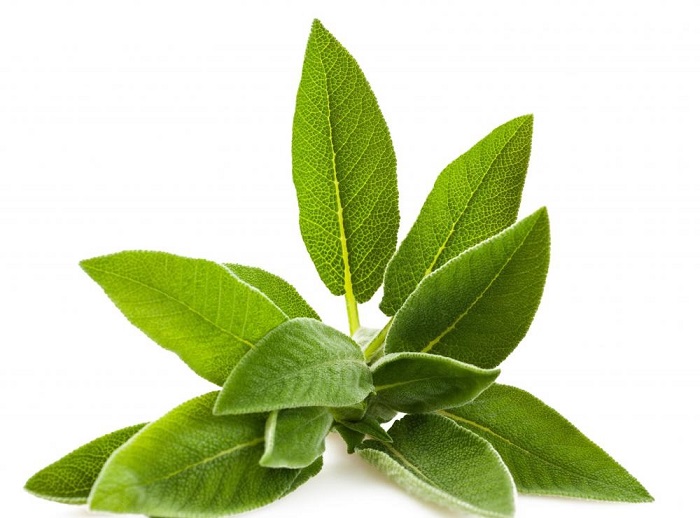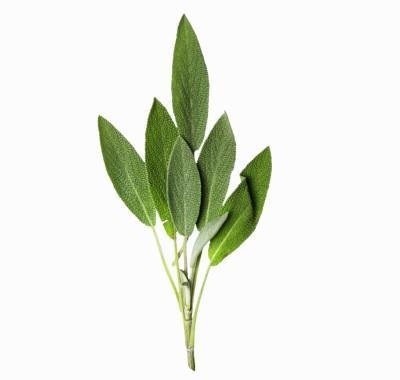Main Name: Sage
Biological Name: Salvia officinalis
Names in other languages: Salvia (Spanish), Salvia, Sefakuss (Hindi), Salvi tulasi (Malayalam), Dharba (Telugu), Bui tulasi (Bengali), Kammarkas (Marathi), Sathi (Punjabi)
Biological Name: Salvia officinalis
Names in other languages: Salvia (Spanish), Salvia, Sefakuss (Hindi), Salvi tulasi (Malayalam), Dharba (Telugu), Bui tulasi (Bengali), Kammarkas (Marathi), Sathi (Punjabi)
Widely known in culinary circles for its savory and pungent aroma, sage is indigenous to the Mediterranean region. Since it is very rare in India, surely, most of you wouldn’t know a herb called sage ever existed. Though you may not be using the herb in your daily cooking, you are still using it every day. Does that ring a bell in your head? If you are a devoted user of deodorants, then consumption of sage comes naturally to you. For, sage is an important ingredient used in most deodorants. Botanically known as Salvia officinalis, sage belongs to the mint family, which also includes basil, rosemary, oregano, thyme and others. It is known by several common names – common sage, garden sage, kitchen sage, true sage, culinary sage, Dalmatian sage, and broadleaf sage, a few to name. An evergreen perennial subshrub spread across the Mediterranean and south-eastern European regions, sage is a plant producing woody stems and grayish leaves that leave a lasting impression. The exquisite aroma and strong woody flavor makes sage a part of many cuisines across the world. Whether you use sage to stuff chicken and turkey, sprinkle over potato dishes and vegetable soups, or pair it up with cheese; sage brings out that required spark and enhances the overall taste of any dish. To add more to your excitement of learning about sage, we present some wholesome benefits of consuming this herb. Read on.
History
Sage is indigenous to the Mediterranean region and has been in use since ancient times as a medicinal herb. It was highly honored by the Greeks and Romans who used it as a meat preservative and for its healing properties. In the 10th century, the Arabs and Romans attributed sage for its ability of imparting immortality. When introduced to the Europeans from Egypt in the 14th century, they used the herb to protect themselves from witchcraft. The popularity of sage increased and reached other parts of the world, where people regarded the herb with utmost respect. Today it is used as an effective treatment for numerous diseases and ailments. The International Herb Association awarded sage with the title ‘Herb of the Year’ in 2001. It is extensively used in Greek, Italian, and European cuisines. Currently, it is cultivated in Yugoslavia, Italy, Albania, Turkey, Portugal, Spain, Cyprus, England, Canada, and the United States. In India, it is sparingly grown in Jammu.
Sage is indigenous to the Mediterranean region and has been in use since ancient times as a medicinal herb. It was highly honored by the Greeks and Romans who used it as a meat preservative and for its healing properties. In the 10th century, the Arabs and Romans attributed sage for its ability of imparting immortality. When introduced to the Europeans from Egypt in the 14th century, they used the herb to protect themselves from witchcraft. The popularity of sage increased and reached other parts of the world, where people regarded the herb with utmost respect. Today it is used as an effective treatment for numerous diseases and ailments. The International Herb Association awarded sage with the title ‘Herb of the Year’ in 2001. It is extensively used in Greek, Italian, and European cuisines. Currently, it is cultivated in Yugoslavia, Italy, Albania, Turkey, Portugal, Spain, Cyprus, England, Canada, and the United States. In India, it is sparingly grown in Jammu.
Health Benefits of Sage
- An outstanding memory enhancer, sage promotes better brain functioning and is an effective remedy for cerebrovascular disease. Besides, it makes a good treatment for Alzheimer’s disease.
- Due to its anti-inflammatory properties, sage effectively cures inflammation of the stomach and intestines. Furthermore, inflammation on the skin, ingestion caused due to spicy foods, inflammation occurring due to high fever, and detoxification of the blood in case of poisonous material in the bloodstream are successfully treated with sage.
- People with inflammatory conditions, like rheumatoid arthritis, bronchial asthma, and atherosclerosis are recommended to increase their intake of sage as a seasoning in food.
- With anti-bacterial properties, sage is used for alleviating bacterial infections occurring in the intestines, urethra, genitals, eyes, throat, nose and ears.
- Sage is an excellent source of antioxidants that clear up the metabolism and other environmental toxins like smoke and pesticides, from the body. Additionally, these antioxidants protect free radicals from damaging the cell tissues, prevent early aging, and reduce the risk of cancer and heart disease.
- Studies have revealed the usage of sage associated with modulating mood and providing effective means of handling stress. It boosts the overall mood and enhances alertness, calmness, and contentedness.
- Symptoms of menopause, like hot flushes, insomnia, nocturnal sweating, dizziness, headaches, palpitations and other signs of an estrogen deficiency are effectively relieved with sage tea in menopausal women.
- Fungal infections, like dermatitis, athlete’s foot, and other skin diseases and ailments are cured with sage due to the presence of Camphor and Camphene that contain anti-fungal properties.
- Sage is an excellent digestive aid and appetite stimulant. It helps in reducing gas in the intestines and relieving abdominal cramps and bloating.
- Oral and dental problems, such as mouth ulcers, infected and bleeding gums, dental abscesses and throat infections are also effectively healed with sage consumption.
- Sage, when taken in tea, works as an expectorant for producing sweat and flushing out toxins, thereby relieving bronchitis, cold and flu symptoms.
- It is used by nursing mothers to stop the production of breast milk when weaning a child from breastfeeding and starting to introduce other food articles.
- Sage is highly recommended for reducing dizziness and nervousness, and strengthening the nervous system that has been incapacitated.
- Some other health advantages associated with sage include curing typhoid fever, laryngitis, tonsillitis, sore throat, liver complaints, kidney troubles, hemorrhage from the lungs or stomach, colds in the head, menstrual bleeding, measles, pains in the joints, lethargy and palsy.
 http://www.wisegeek.com/what-is-the-purpose-of-burning-sage.html
http://www.wisegeek.com/what-is-the-purpose-of-burning-sage.htmlSage Nutrition FactsAmount: 100 g
Total Weight: 100 g
Total Weight: 100 g
| Nutrients | Amount |
| Basic Components | |
| Proteins | 11 g |
| Water | 8 g |
| Ash | 7.9 g |
| Phytosterols | 244 mg |
| Calories | |
| Total Calories | 315 |
| Calories From Carbohydrate | 182 |
| Calories From Fat | 107 |
| Calories From Protein | 26 |
| Carbohydrates | |
| Total Carbohydrates | 61 g |
| Dietary Fiber | 40 g |
| Sugar | 1.7 g |
| Fats & Fatty Acids | |
| Total Fat | 13 g |
| Saturated Fat | 7 g |
| Monounsaturated Fat | 1.9 g |
| Polyunsaturated Fat | 1.8 g |
| Omega-3 Fatty Acids | 1.2 g |
| Omega-6 Fatty Acids | 530 mg |
| Vitamins | |
| Vitamin A | 5900 IU |
| Vitamin C | 32 mg |
| Vitamin E | 7.5 mg |
| Vitamin K | 1.7 mg |
| Thiamin | 754 mcg |
| Riboflavin | 336 mcg |
| Niacin | 5.7 mg |
| Vitamin B6 | 2.7 mg |
| Folate | 274 mcg |
| Choline | 43.6 mg |
| Minerals | |
| Calcium | 1.7 g |
| Iron | 28 mg |
| Magnesium | 428 mg |
| Phosphorus | 91 mg |
| Potassium | 1.1 g |
| Sodium | 11 mg |
| Zinc | 4.7 mg |
| Copper | 757 mcg |
| Manganese | 3.1 mg |
| Selenium | 3.7 mcg |
 http://motherhood.modernmom.com/picking-sage-leaves-5647.html
http://motherhood.modernmom.com/picking-sage-leaves-5647.html
How many calories in sage (per 100 gm)
Sage has about 315 calories per 100 gm of weight.
Sage has about 315 calories per 100 gm of weight.
How to Buy Sage
- Sage can be purchased fresh, dried` or ground from the supermarkets all round the year.
- Whenever possible, buy fresh bunches of sage as it will give you a superior and more aromatic flavor.
- Look for fresh sage bunches with vibrant green-gray leaves and fresh aromatic smell.
- Avoid purchasing sage leaves that have blemishes, yellow spots, mold, or wilt.
- When buying dried or ground sage, look for authentic and known branded packets only, to obtain the best quality.
Sage Storage Tips
- Wrap fresh sage leaves in paper towels and place them in a loosely closed plastic bag. Refrigerate and use within four to five days.
- Fresh sage leaves can also be covered in olive oil and stored in the refrigerator. This way, the leaves will keep fresh for about three weeks.
- You can freeze sage leaves to increase their shelf live and retain their freshness. Wash, pat dry the sage leaves, separate the leaves from the stems, pack loosely in a freezer bag. Place in the freezer for up to one year.
- Store dried sage in an airtight glass container in a cool, dark, dry place where it will last for about six months.



